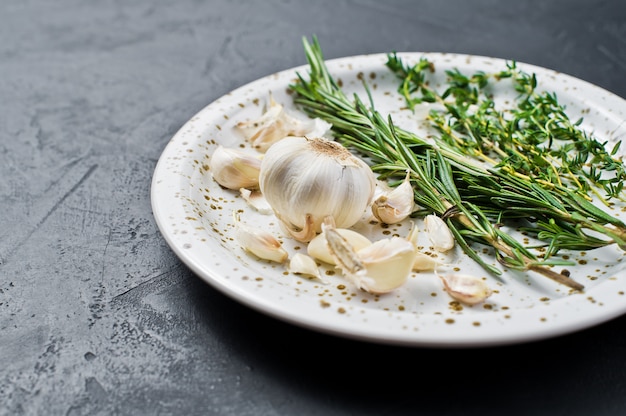Rosemary & Thyme: From Garden To Plate

Table of Contents
Cultivating Your Own Rosemary & Thyme Garden
Growing your own rosemary and thyme is surprisingly easy and incredibly rewarding. These hardy herbs thrive with minimal care, providing you with a constant supply of fragrant leaves for your culinary creations.
Choosing the right location:
- Sunlight: Both rosemary and thyme need at least 6-8 hours of direct sunlight daily. Choose a sunny spot in your garden or a sunny windowsill if growing indoors.
- Soil Drainage: Well-drained soil is crucial. Avoid areas prone to waterlogging, as this can lead to root rot. Amend heavy clay soils with compost to improve drainage.
- Space Requirements: Rosemary can become quite large, so allow ample space (at least 1-2 feet) between plants. Thyme is more compact and can be planted closer together (6-12 inches).
Planting methods:
- Seeds: Starting from seeds is possible, but it can be slower than other methods. Sow seeds indoors 6-8 weeks before the last frost.
- Cuttings: Rosemary and thyme propagate easily from cuttings. Take 4-6 inch cuttings in spring or summer and plant them directly in the ground or in pots.
- Established Plants: Buying established plants from a garden center is the quickest way to get started.
Ongoing care:
- Watering: Water regularly, especially during dry spells, but avoid overwatering. Allow the soil to dry slightly between waterings.
- Fertilizing: These herbs are relatively low-maintenance and don't require heavy fertilization. A light application of balanced fertilizer in spring is sufficient.
- Pest Control: Rosemary and thyme are generally pest-resistant, but occasional infestations can occur. Monitor for pests like aphids and use insecticidal soap if necessary.
Potential challenges:
- Root Rot: Overwatering is the main cause of root rot. Ensure good drainage and avoid letting the soil become soggy.
- Fungal Diseases: Good air circulation helps prevent fungal diseases. Avoid overhead watering to keep foliage dry.
- Pest Infestations: Regularly inspect plants for pests and address infestations promptly using appropriate methods.
Harvesting:
Harvest rosemary and thyme sprigs regularly to encourage bushier growth. The best time to harvest is in the morning after the dew has dried. Use sharp scissors to snip off stems, leaving some foliage behind to allow for regrowth.
Rosemary & Thyme in the Kitchen: Unlocking Culinary Potential
The culinary uses of rosemary and thyme are virtually limitless. Their distinct flavors add depth and complexity to a wide range of dishes.
Rosemary's robust flavor profile:
- Roasted Meats: Rosemary's strong, piney aroma pairs beautifully with lamb, chicken, and beef. Try adding sprigs to your roasting pan for a wonderfully aromatic roast. [Link to a rosemary roasted lamb recipe]
- Potatoes: Toss roasted potatoes with chopped rosemary and olive oil for a simple yet flavorful side dish.
- Bread: Incorporate rosemary into bread dough for a fragrant and flavorful loaf.
Thyme's subtle earthiness:
- Soups & Stews: Thyme's delicate earthiness adds warmth and complexity to soups and stews.
- Sauces: Add a sprig or two of thyme to your favorite sauces for an extra layer of flavor.
- Poultry: Thyme is a classic pairing with chicken and turkey, adding a savory dimension to these dishes. [Link to a thyme-roasted chicken recipe]
Creative pairings:
Rosemary and thyme complement many other herbs and spices, creating exciting flavor combinations. Consider pairing them with:
- Garlic
- Lemon
- Oregano
- Sage
Preserving your harvest:
- Drying: Hang sprigs upside down in a cool, dry, and well-ventilated area.
- Freezing: Chop fresh herbs and freeze them in ice cube trays with a little olive oil or water.
- Infusing: Infuse rosemary and thyme in olive oil or vinegar for a flavorful addition to your cooking.
Health Benefits of Rosemary & Thyme
Beyond their culinary uses, rosemary and thyme possess potential health benefits attributed to their rich antioxidant and anti-inflammatory properties.
Antioxidant properties: Rosemary and thyme are rich in antioxidants, which help protect your cells from damage caused by free radicals.
Anti-inflammatory effects: Studies suggest that both herbs may have anti-inflammatory properties.
Other potential health benefits: While further research is needed, some studies suggest additional potential benefits. (Note: Always consult a doctor before using herbs for medicinal purposes).
Important Note: This information is for educational purposes only and should not be considered medical advice. Consult a healthcare professional for any health concerns.
Conclusion
Growing your own rosemary and thyme offers a delightful experience, connecting you with nature while enhancing your culinary adventures. From the simple joy of tending your herb garden to the satisfaction of using fresh herbs in your favorite dishes, the rewards are plentiful. Embrace the versatility of these aromatic herbs and embark on your culinary journey with rosemary and thyme today! Grow your own fresh herbs for amazing flavor and experience the joy of harvesting your own rosemary and thyme. Start your own rosemary and thyme garden today!

Featured Posts
-
 Complete Guide To The Nyt Mini Crossword April 8 2025 Tuesday
May 31, 2025
Complete Guide To The Nyt Mini Crossword April 8 2025 Tuesday
May 31, 2025 -
 Who Are Bernard Keriks Wife And Children A Family Overview
May 31, 2025
Who Are Bernard Keriks Wife And Children A Family Overview
May 31, 2025 -
 Economists Urge Ecb Caution Avoiding Rate Cut Delays
May 31, 2025
Economists Urge Ecb Caution Avoiding Rate Cut Delays
May 31, 2025 -
 Massive Wildfires Force Largest Evacuation In Canadian History Us Air Quality Suffers
May 31, 2025
Massive Wildfires Force Largest Evacuation In Canadian History Us Air Quality Suffers
May 31, 2025 -
 Former Mlb Star Brandon Inge Back In The Dugout In Kalamazoo
May 31, 2025
Former Mlb Star Brandon Inge Back In The Dugout In Kalamazoo
May 31, 2025
